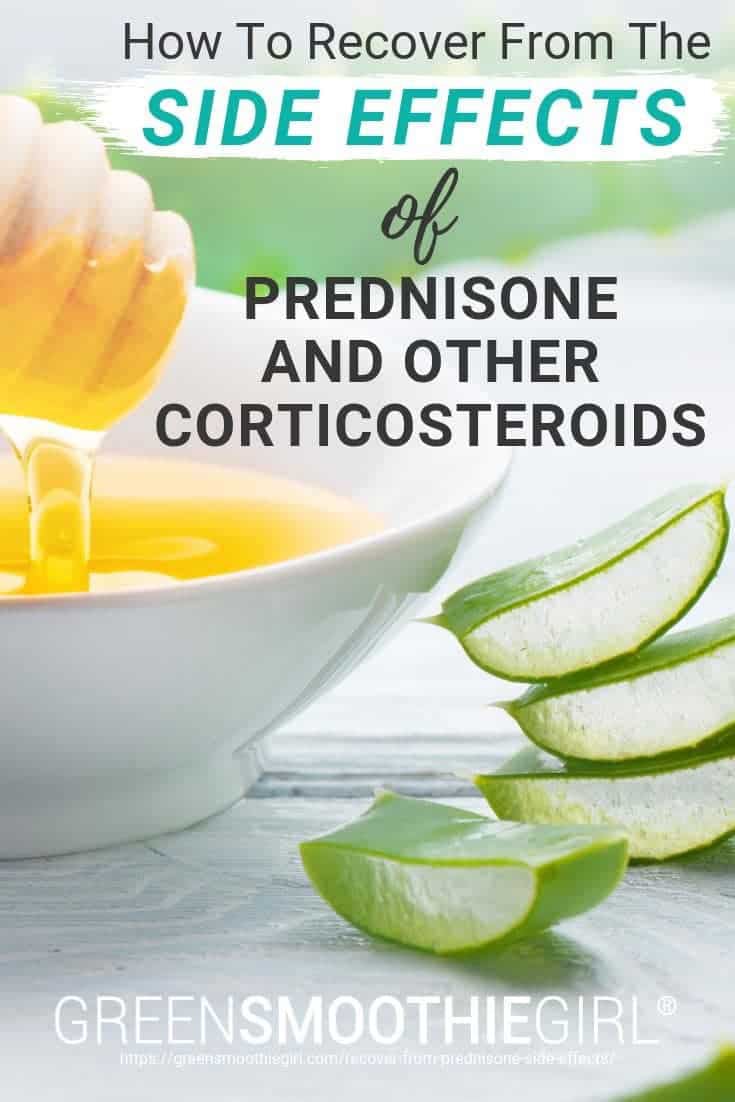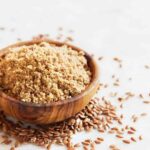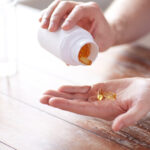How To Recover From The Side Effects Of Prednisone And Other Corticosteroids

Steroids are chemicals that our body naturally produces in the adrenal glands. These important chemicals play a major role in supporting our health and are responsible for hormonal systems such as those controlling body temperature as well as blood pressure. Pretty important stuff. But more is not always better.
When we take the synthetic versions of steroids that healthcare providers prescribe, our bodies can react with unpleasant physical and emotional side effects.
But getting off steroids like prednisone or hydrocortisone isn’t simply a matter of quitting cold turkey. Your body will need time to recover from the side effects of prednisone and other corticosteroids, and you’ll want to make the transition as easy as possible with strategies for recovery.
In this article:
- Anabolic Steroids Vs. Corticosteroids
- What Are The Side Effects of Corticosteroids?
- Helping Your Body Heal During A Prednisone Taper
- Final Thoughts on Steroid Use Recovery
Anabolic Steroids Vs. Corticosteroids
There are two main classes of steroids that healthcare providers may prescribe, and it’s important to distinguish the type we are discussing, corticosteroids, from anabolic steroids.
What Are Anabolic Steroids, and Why Are They Prescribed?
Anabolic steroids are synthetic derivatives of testosterone, a hormone naturally produced by the body. Anabolics are typically used by bodybuilders and those looking to gain muscle mass and strength. Patients with AIDS are also prescribed anabolic steroids in order to prevent the characteristic wasting that accompanies this disorder. In addition, healthcare providers sometimes prescribe them for individuals with cancer or abnormally low testosterone levels.
Because recovery from taking anabolic steroids is much different than from corticosteroids, for simplicity’s sake I will not be discussing anabolics further in this article.
What Are Corticosteroids, and What Are They Prescribed to Treat?
Corticosteroids, such as hydrocortisone and prednisone, are also called glucocorticoids. They are synthetic versions of your naturally-occurring glucocorticoid hormone cortisol. While your body naturally produces between 20-25mg of cortisol per day, steroids such as prednisone are given in much larger doses, usually prescribed to treat inflammation that causes swelling, pain, or allergic reactions.
Unfortunately, in many cases, these large doses of synthetic corticosteroids only serve to mask rather serious signs and symptoms the person is experiencing, and can cause side effects of their own from which it is difficult to recover. According to Johns Hopkins Arthritis Center, in reference to prednisone, “There is likely no totally safe dose.” 1
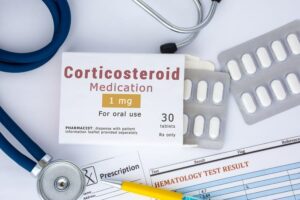
Corticosteroid is given to treat inflammation, but often masks the underlying issue and causes addition.
What Are the Side Effects of Corticosteroids?
Clinical studies reveal a long list of long-term side effects from corticosteroids that include osteoporosis, increased risk of heart disease, high blood pressure, diabetes, muscle weakness, liver and kidney disease, cataracts and glaucoma, as well as weight gain.2 One of the more visible side effects is swelling of the face and neck, otherwise known as “moon face.”
Even short-term use of these steroids can result in mood changes, fluid retention, indigestion, immune suppression, and insomnia. Many people report swollen hands and feet.
Steroid Dependence
Taking corticosteroids for just two weeks can result in what is referred to as an “altered response to physical stress.” This happens when your pituitary and hypothalamus stop signaling your adrenal glands to make more cortisol because of the synthetic cortisol that is in your body. Your body becomes dependent on your intake of cortisol, which is the main reason you can’t just quit these synthetics without weaning off of them–your body needs time to begin making your own cortisol again and for your other hormones to rebalance.
According to the National Adrenal Diseases Foundation, recovery from steroid use is equal to the time you’ve been taking the drug. In other words, if you’ve taken corticosteroids for one month, it will take about a month for your body to return to its natural and normal levels of steroid production. Unfortunately, some people never recover. Symptoms associated with this secondary disease include severe fatigue, loss of appetite, nausea, muscle weakness, irritability and depression.3
Once again, it is a case of prescribed drugs creating a cascading effect that leads to yet another drug, an increase in the existing dose, and sometimes even lifelong dependency.
The longer you have been on corticosteroids, the more important it becomes for you to work with a good functional medicine practitioner (FMD) to help guide you through the process of tapering off of these medications. Not all FMDs are created equal, so make sure to ask them if they have experience with this.

Consult your functional medicine practitioner for guidance through the tapering process.
Prednisone Withdrawal Case Study
One of my clients came to me at 44 years of age with a previous history of joint pain, stiffness upon awakening, and brain fog. She had bounced from healthcare provider to healthcare provider in search of answers and a solution.
One of her physicians was an internal medicine MD. His take on her situation was that he was not completely sure what was going on, but that prednisone should help her symptoms. She had started on a small dose and gradually increased to a moderate dose, at which she stayed for nearly 7 months.
While the prednisone did help her symptoms by masking inflammation, she traded those symptoms for weight gain, fluid retention, and altered blood sugar levels.
When she came to my office and we finally figured out the underlying root causes of her symptoms, she expressed to her local MD her desire to quit the prednisone. Because prednisone suppresses the body’s natural production of cortisol, it’s inadvisable to quit this medication cold turkey.
Thus, while her MD oversaw a very slow taper (discontinuation) of the prednisone, I worked with her to correct the deficiencies and imbalances causing her initial symptoms, plus those that were caused by the prednisone.
It took nearly 8 months and a number of nutritional and supplement changes to reset her body’s own natural production of cortisol, reverse bone loss, improve her blood sugar, and help her achieve her goal.
Your Body’s Healing Power
With the rise of modern medicine, we have somehow forgotten that our miraculous bodies are designed to heal themselves.4 As you read this, your body has just made 2.5 million red blood cells and 250,000 white blood cells. The truth is that while medicine and procedures may help, it is up to our bodies to start and maintain the healing process.
So, what can you do to help your body heal from the effects and harm that taking steroids causes? Let’s take a look at your best course of action.

Your body is designed to heal itself; it is up to us to start and maintain that process.
Helping Your Body Heal During A Prednisone Taper
What Are Prednisone Withdrawal Symptoms?
If you’ve been on corticosteroids like prednisone for some time, you may experience withdrawal symptoms when tapering off of them. Symptoms may include fatigue, muscle and joint pain, nausea, adrenal insufficiency, and low blood sugar and pressure.
How Long Do Withdrawal Symptoms Last?
Withdrawal symptoms from a prednisone taper (or any other taper from corticosteroids) may last anywhere from a few weeks to a year. This too shall pass, and you can speed your recovery time by supporting your body with the right foods, supplements, and mindset.
How to Help Prednisone Withdrawal Symptoms
1. Potassium
This very important mineral is involved in several key body functions, and taking steroids can deplete this vital nutrient. Low potassium levels have been linked to high blood pressure and heart disease, and an increased risk for strokes and kidney stones, irregular muscle contractions, and fatigue.5
In order to help bring your body back into balance, eat foods that are high in this mineral. I recommend adding beet greens, spinach, avocados, bananas, and coconut water to your diet. One of my favorite smoothies, the Super Hulk Green Smoothie, contains three of these ingredients.6 It’s not called “Super Hulk” for no reason!
[Related: Green Smoothies To Balance Female Hormones Naturally]
2. Support Your Bones: Supplements, Sun, Diet, and Activity
One of the main side effects of taking steroids is bone loss. According to the New York State’s Department of Health, a person taking steroids is more than twice as likely to experience a fracture as someone who is not on steroids.7
Eating a “bone healthy” diet is crucial to ensuring your bones have the support they need to stay strong.
So, just what nutrients do your bones require? We know that calcium is an important mineral, the building block of our bones, and that vitamin D (which is actually a hormone) helps our bodies absorb calcium. In addition, you’ll need a dose of vitamin K2, zinc, magnesium, manganese, and phosphorus.
Taking supplements is not always, or even usually, the answer. Most nutrients require the synergistic effect that the combination found in food provides—never mind the toxic chemicals that are often used during the manufacturing of many supplements.
Committing to a whole-food, plant-based diet is the best way to ensure you obtain these all-important nutrients. Specific sources of bone-healthy vitamins and minerals include beans, lentils, seeds, dark, leafy greens such as kale, and nuts such as almonds. Ancient grains like amaranth and quinoa are also good sources of magnesium, manganese, phosphorus, and even some calcium.
And don’t forget to spend some time in the light of the sun. Like plants that convert the energy found in sunlight into sugar, your body, in a series of chemical reactions, makes vitamin D from sunlight. You’ll need to expose your bare skin in order for your body to make this hormone.
I recommend exposing as much surface area of your body as possible to the sun for 20-30 minutes first thing in the morning and for the same amount of time in the evening. Sunlight provides much more than just Vitamin D; It allows us to receive natural blue light, which supercharges the mitochondria, the batteries of our cells.
What about during the winter, or in northern climates, when there’s not much daylight and it’s too cold to be outside for very long? You’ll likely need an oral Vitamin D supplement. Be sure that it comes in the form of Vitamin D3, which is more readily absorbed by the body, and that it is free of artificial colors, hydrogenated oils, talc or magnesium silicate, and titanium dioxide. (I know, it’s hard to believe, but supplements can contain a mass of dangerous, toxic ingredients. Thank you, FDA!)
[Related: Can You Spot Neurotoxins In Your Food?]
If you do choose to take an oral Vitamin D3 supplement, please ensure that you also take Vitamin K2, which helps your body use Vitamin D3.
Whole-food supplements, which are derived from concentrated and dehydrated whole foods, are always preferred.
Remember to include weight-bearing exercises in your daily routine such as running, rebounding, and weightlifting—all of which strengthen and increase bone density at risk from steroid use.
3. Lower Your Cholesterol Level
Steroids increase cholesterol levels. One study showed that corticosteroid use for as little as two days can significantly increase HDL cholesterol levels in otherwise healthy men.8
Cholesterol is a natural substance made by the liver, and it’s essential to several body functions, including maintaining the structure of cell walls and producing vitamin D as well as several other key hormones.
Like most things in life, however, there is a fine line between enough and too much of a good thing. High cholesterol levels can lead to fatty plaque developing on the arterial walls, ultimately narrowing them, reducing blood flow, and increasing the risk of a heart attack or stroke.
You can counteract the increasing cholesterol effect of steroids by eating a diet rich in:
- soluble fiber, which binds to cholesterol and draws it out of the body
- unsaturated fats that lower LDL
- plant sterols and stanols that reduce the absorption of this fat
Let’s take a look at each of these components separately.
Good sources of soluble fiber include whole-grain oats and barley, lentils, beans, cruciferous vegetables, apples, and asparagus.
Unsaturated fats are found in olive oil (I recommend extra-virgin), avocados, organic coconut oil, nuts and seeds.
Plant sterols and stanols, also known as phytosterols, are phytochemicals found in plants that reduce the absorption of cholesterol. They are found in vegetables and fruits, grains, beans, nuts, and seeds. Particularly good vegetable sources include Brussels sprouts, broccoli, cauliflower, avocado, apples, and blueberries. Recommended nuts and seeds include pistachios, macadamia nuts, almonds, and sesame seeds.
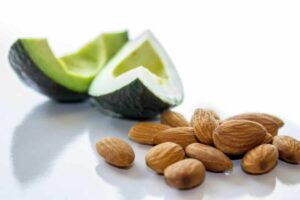
Unsaturated fats found in healthful foods lowers cholesterol naturally.
4. Support Insulin Sensitivity: Chromium, Magnesium, and Food Choices
Steroids interfere with the production of insulin, which ultimately can lead to what is known as steroid-induced diabetes. Created by the pancreas, insulin delivers sugar from the bloodstream into your cells where it is used as fuel and energy. Diabetes occurs when the pancreas is unable to produce insulin or, as in the case of steroid-induced diabetes, when it is unable to produce the amount of insulin needed to overcome the effects of these types of drugs.
[Related: Green Smoothies For Diabetes: Mistakes, Tips, And Recipes]
Chromium: A study published in Diabetic Medicine found that patients with steroid-induced diabetes who were given 600 µg of chromium (in the form of chromium picolinate) every day reduced their hypoglycemic drug intake by 50 percent.9
The best choice is a whole food organic GTF (Glucose Tolerance Factor) chromium supplement.
Magnesium: Because elevated cortisol levels can contribute to insulin resistance and even diabetes, everything possible must be done to restore insulin sensitivity. This requires less insulin production from the pancreas.
Magnesium participates in thousands of biochemical reactions in the human body. One primary benefit of magnesium is improved glucose tolerance. A magnesium glycinate or magnesium chelate form is best. I recommend taking with food.
Food And Insulin Sensitivity: Of course, it’s extremely important to pay attention to your diet, which should consist of whole foods with little to no processed foods that are often high in white flour, sugar, and high fructose corn syrup. Eat whole unprocessed grains and avoid white bread, pasta, and rice. Limit your diet to leafy greens and other vegetables, fruits, whole grains, legumes, nuts, and seeds.
There seems to be a dietary pattern developing, no?

Your diet impacts your recovery from steroid use.
5. Support the Gastrointestinal Tract With Foods and Herbs
Mucous is a protective layer that helps defend delicate tissues from an acidic environment. Steroids suppress the growth of gastric mucin in the stomach, which suppresses the production of mucous. This may ultimately lead to gastroesophageal reflux (also known as heartburn) and ulcers.
While healing the delicate lining of your stomach, you’ll want to limit your intake of foods that increase gastric acid. These include packaged and processed foods, fried foods, citrus fruits, chocolate, caffeine, and alcohol.
There are also several foods that you can add to your diet that help nourish and rebuild the lining of the gut. This includes bone broth, a whole food that was once a staple of many traditional cultures and one that is rich in protein. It also contains gelatin, a substance known to aid in the healing of the lining of the gastrointestinal tract, and glycine, an amino acid that promotes a healthy mucosal lining in the stomach.10
If you’re making your own bone broth or buying a powdered version, make sure that the bones come from cows that are grass-fed.
[Related: 23 Ways To Use Bone Broth Protein]
Another great source of gastrointestinal is aloe vera, a succulent that has been used as a medicinal plant for thousands of years. Several studies demonstrate its ability to help heal gastric ulcers.11
Raw honey is another common ingredient known for its many health benefits, including reducing the risk of heart disease and stroke, improving eye health, and healing wounds as well as stomach ulcers.12 Raw, local, organic honey is your best choice.
There are many other options to consider when choosing to add gut-healing foods to your diet. These include fermented foods, ginger, and apple cider vinegar. One of my all-time favorites is cabbage juice. In one study, patients’ ulcers healed up to 6 times faster when they received one quart of fresh cabbage juice every day.13
6. Pregnenolone
Pregnenolone is known as the “mother hormone.” Pregnenolone can be converted into many downstream hormones, including cortisol.
You may be thinking, “Why would I take one kind of steroid to recover from another?” One major difference lies in the fact that there are no negative feedback loops to your brain when it comes to pregnenolone; this means it won’t decrease your body’s natural production of any hormones. Pregnenolone will allow for a much smoother transition off of prednisone or hydrocortisone.
While you can find pregnenolone over the counter, I recommend working with a functional medicine practitioner to help you get the right dosage for your situation, from a compounding pharmacy.

Pregnenolone is known as the mother hormone and can help the transition off prednisone or hydrocortisone.
7. Strengthen the Mind-Body Connection
When promoting healing after any type of drug use, it’s important to consider the mind-body connection. After all, the beliefs you hold influence your mental and physical health. If you believe that taking steroids will impact your health in the future, they most likely will.
Positive belief makes every day a little lighter, while the effects of negative thinking include increased stress and worry, ultimately impacting your immune system. Dr. Hans Seyle conducted extensive studies on how stress interferes with the body’s ability to heal. He was awarded a Nobel Prize in 1950 for his research on stress and glucocorticoids.15
Did you know that certain words and intentions have been shown to cause physical changes in the structure of your DNA? A study conducted by Dr. Carlson found that breast cancer patients could influence the makeup of their DNA by practicing an adapted form of Buddhist meditation that brought focus to the present in a non-judgmental way. 16
[Related Vibe Podcast Episode: The Biology Of Belief: Interview With Dr. Bruce Lipton]
As you can see from these recommendations, to recover from the effects of steroids, it’s best to eat a plant-based diet, adding specific foods that help your body restore the nutrients that become depleted due to the influence of synthetic steroids.
Final Thoughts On Steroid Use Recovery
Given time and the right support, your body will heal from steroid use. The swelling will subside, the irritability will lift, and the feeling of weakness will be replaced by strength. Your body just needs a little help to rid itself of these toxic chemicals.
In addition to eating the foods listed above and making sure you get yourself moving at least 30 minutes a day, following up with a detoxification program will help restore, cleanse, and nourish your body. I recommend Robyn’s 26-Day Detox program, which gives your body the time and nutrients that it needs to rid itself of toxic chemicals and even blocked emotions.
So, while you’re detoxifying and bringing your body back into balance, don’t forget to include activities that reduce your stress levels and bring you back to the present. For some, this may include meditation, yoga, spending time in nature, or hiking back-wilderness trails. For others, peace comes in the form of a daily game of tennis or golf. As Deepak Chopra, a medical doctor and pioneer in the field of mind-body medicine, once said, “The past is gone; the future is not here, now I am free of both. Right now, I choose joy.”
Read Next: What To Do After You’ve Taken Antibiotics

Sources
-
- Matsumoto, Alan M.D. Any Alternatives for Prednisone. John Hopkins Arthritis Center. 03/2007. https://www.hopkinsarthritis.org/ask-the-expert/any-alternatives-for-prednisone/
- Rice, JB et al. Long-term Systemic Corticosteroid Exposure: A Systematic Literature Review. Clinical Therapies. 11/2017. https://www.ncbi.nlm.nih.gov/pubmed/29055500
- What is Secondary Adrenal Insufficiency? National Adrenal Diseases Foundation. https://www.nadf.us/adrenal-diseases/secondary-adrenal-insufficiency/
- Carr, Teresa. Too Many Meds? America’s Love Affair With Prescription Medication. Consumer Reports. 08/2017. https://www.consumerreports.org/prescription-drugs/too-many-meds-americas-love-affair-with-prescription-medication/
- Yang, Q et al. Sodium and potassium intake and mortality among US adults: prospective data from the Third National Health and Nutrition Examination Survey. Archives of Internal Medicine. 07/2011. https://www.ncbi.nlm.nih.gov/pubmed/21747015
- Openshaw, Robyn. Super Hulk Green Smoothie. Green Smoothie Girl. https://greensmoothiegirl.com/recipes/super-hulk-green-smoothie/
- Osteoporosis and Steroid Medications. New York Department of Health. https://www.health.ny.gov/publications/1985/index.htm
- Taskinen, MR et al. Short-term effects of prednisone on serum lipids and high density lipoprotein subfractions in normolipidodemic healthy men. Journal of Clinical Endocrinology and Metabolism. 08/1988. https://www.ncbi.nlm.nih.gov/pubmed/3134387
- Ravina, A et al. Reversal of corticosteroid-induced diabetes mellitus with supplemental chromium. Diabetic Medicine. 12/2001. https://onlinelibrary.wiley.com/doi/pdf/10.1046/j.1464-5491.1999.00004.x
- De Pietro, MaryAnn. Eight Health Benefits of Gelatin. Medical News Today. 08/2017. https://www.medicalnewstoday.com/articles/319124.php
- Avijgan, Majid et al. Effectiveness of Aloe Vera Gel in Chronic Ulcers in Comparison with Conventional Treatments. Iranian Journal of Medical Sciences. 05/2016. https://www.ncbi.nlm.nih.gov/pmc/articles/PMC5103537/
- Eteraf-Oskouei et al. Traditional and Modern Uses of Natural Honey in Human Diseases: A Review. Iranian Journal of Basic Medical Sciences. 06/2013. https://www.ncbi.nlm.nih.gov/pmc/articles/PMC3758027/
- Cheney, Garnett. Rapid Healing of Peptic Ulcers in Patients Receiving Fresh Cabbage Juice. Western Journal of Medicine. 01/1949. https://www.ncbi.nlm.nih.gov/pmc/articles/PMC1643665/
- Openshaw, Robyn. 26-Day Detox. Green Smoothie Girl. https://greensmoothiegirl.com/programs/26-day-detox/
- Szabo S. et al. The legacy of Hans Selye and the origins of stress research: a restrospective 75 years after his landmark bried “letter” to the editor# of nature. Stress. 09/2012. https://www.ncbi.nlm.nih.gov/pubmed/22845714
- Stetka, Bret. Changing Our DNA Through Mind Control? Scientific American. 12/2014. https://www.scientificamerican.com/article/changing-our-dna-through-mind-control/
Disclosure: This post may contain affiliate links that help support the GSG mission without costing you extra. I recommend only companies and products that I use myself.
Posted in: Detox, Emotional Health, Health Concerns, Holistic Care, Mind/Body Connection, Supplements, Whole Food



